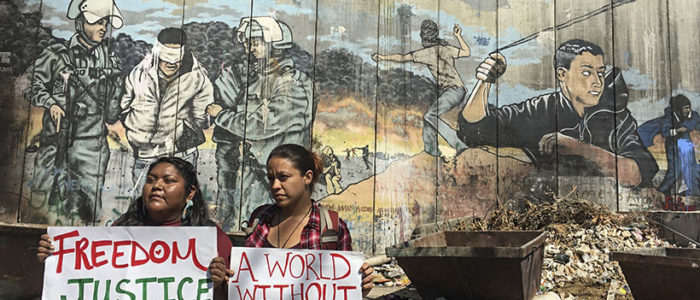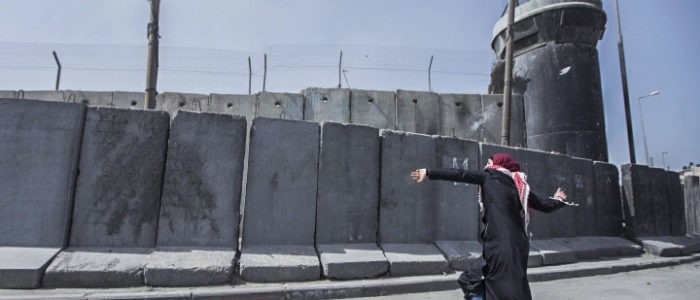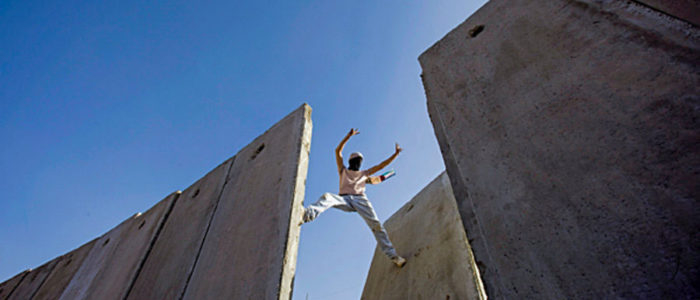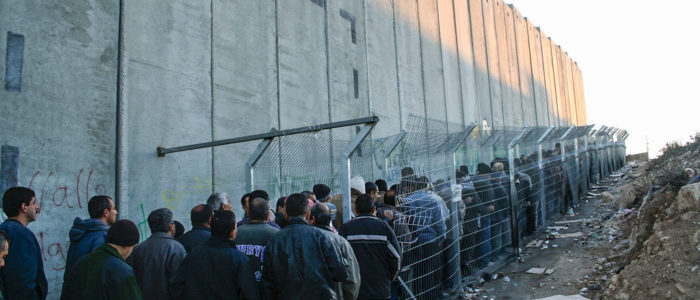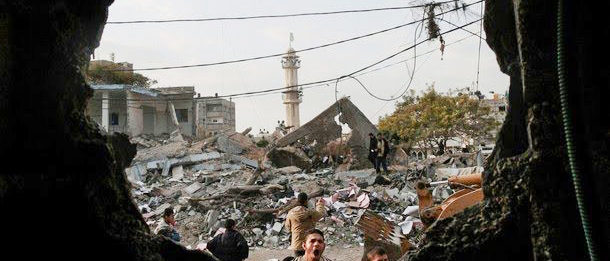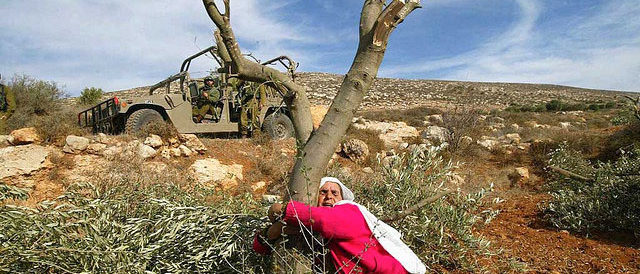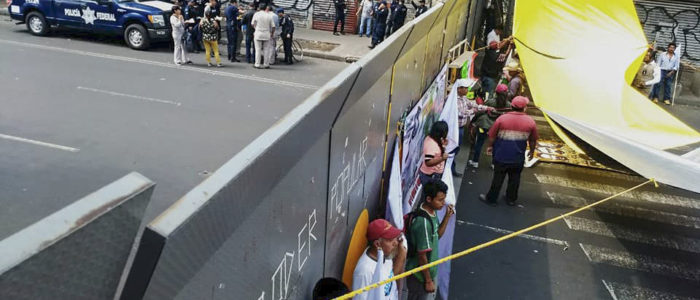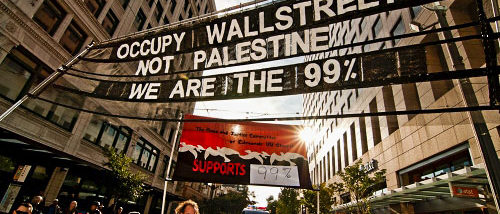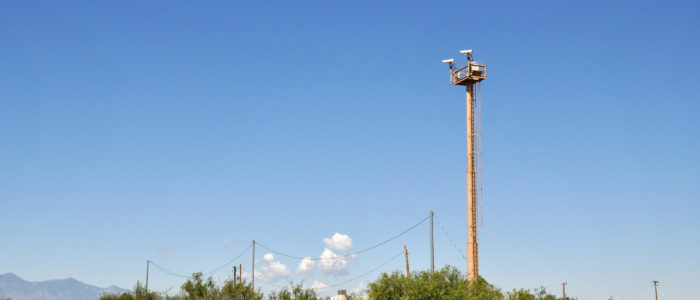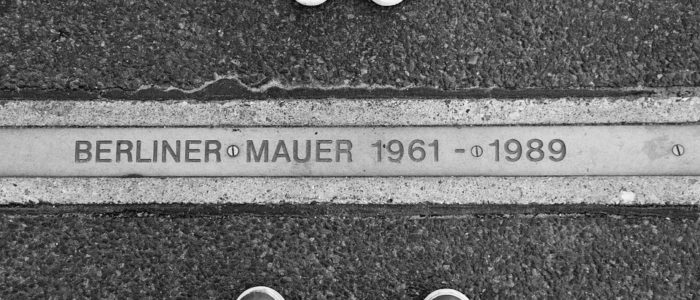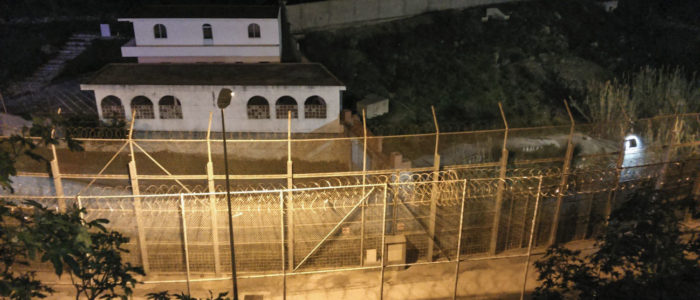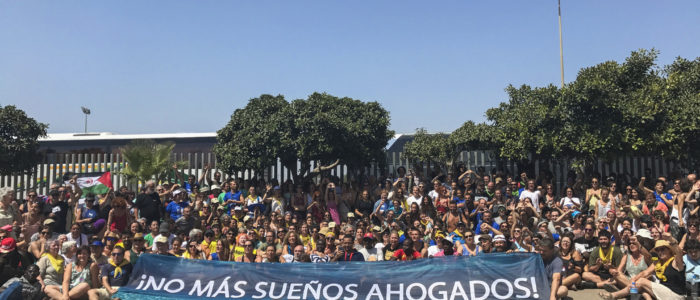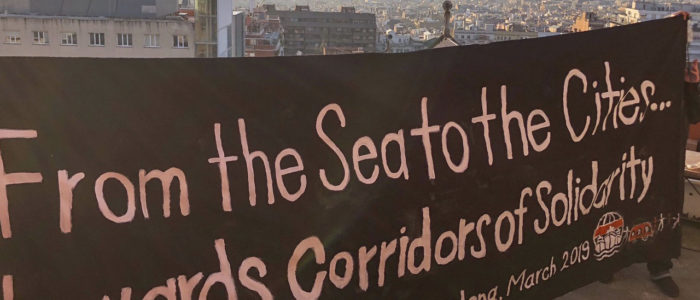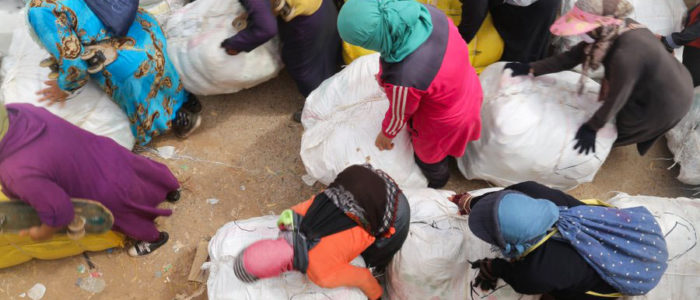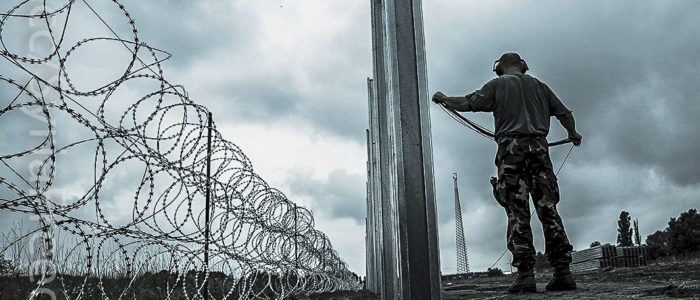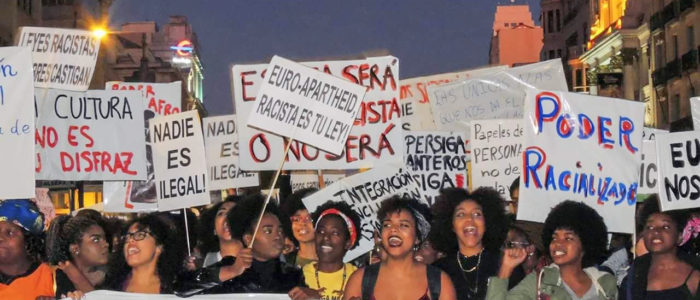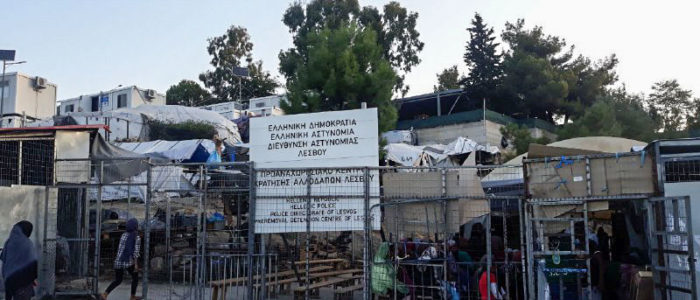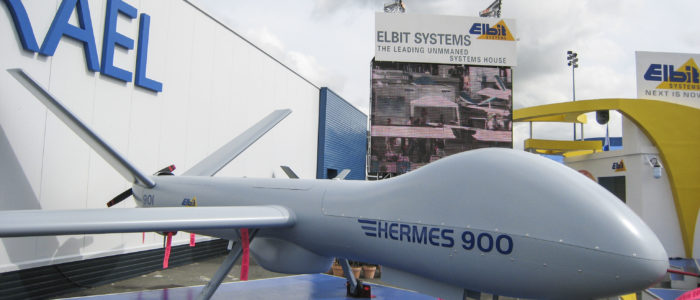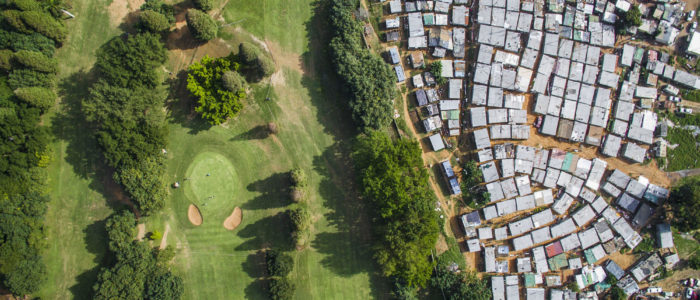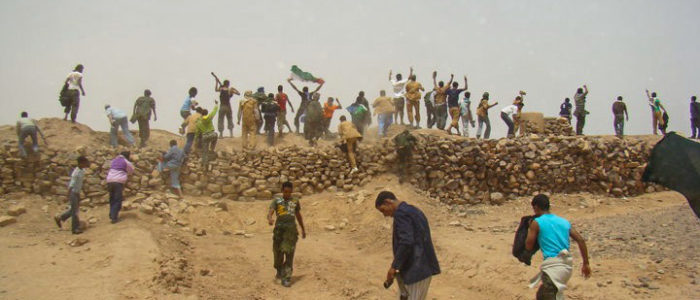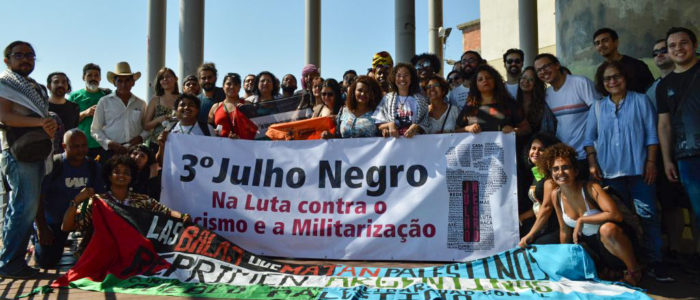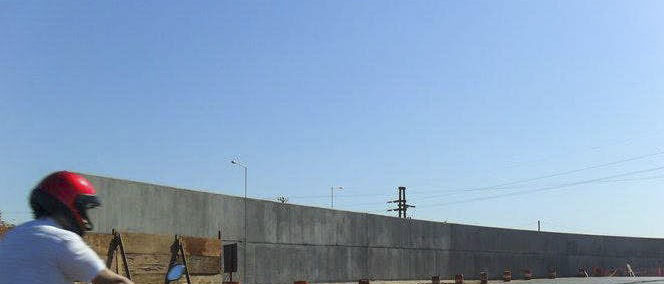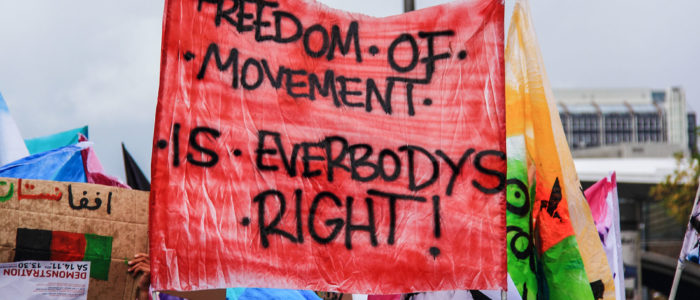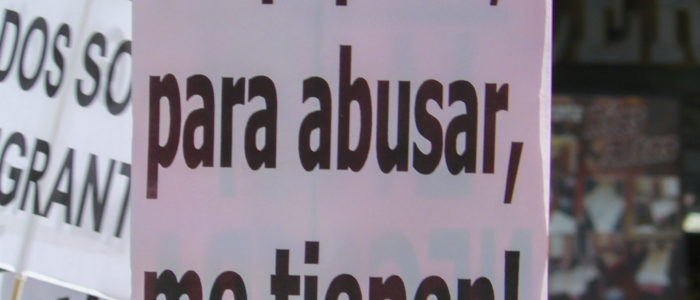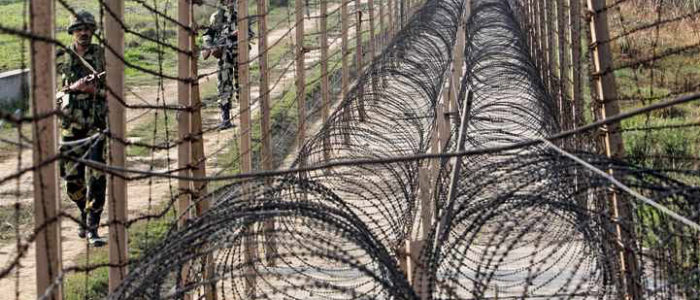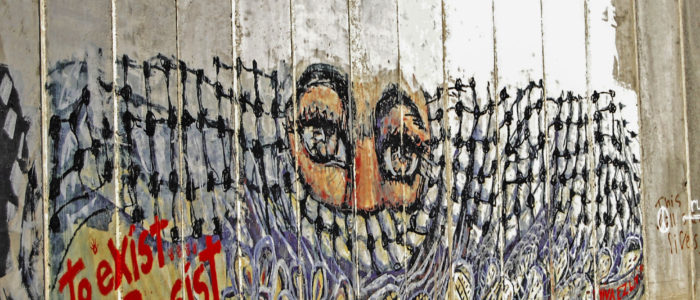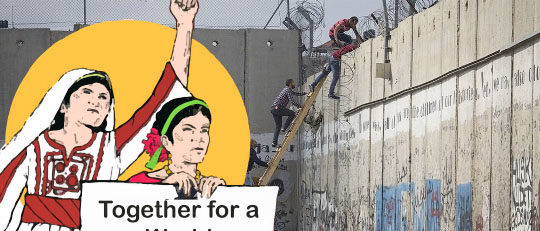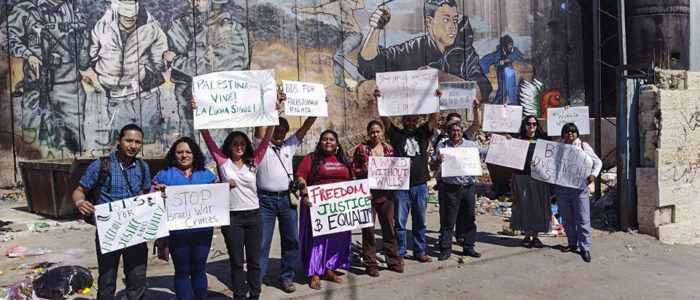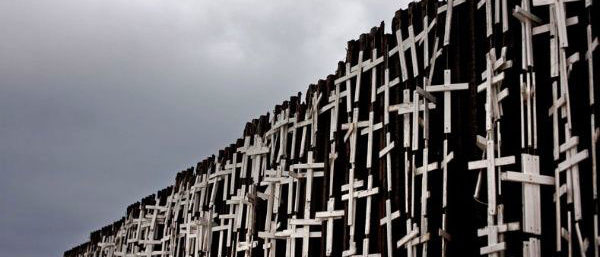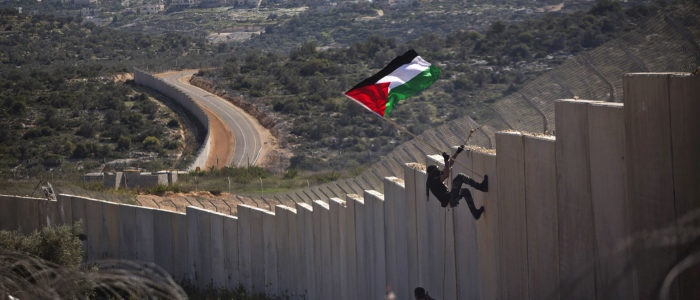The policies and industry behind the European walls1
The drone developed by Elbit Systems during the attacks in Gaza and used by the European Agency for Maritime Security (EMSA). Aeronautics expo Paris 2007. (Credits: Matthieu Sontag (CC-BY-SA).)
Thirty years after the fall of the Berlin Wall, European countries have built over 1000 kilometres of land border walls and fences, mostly to stop refugees.2 They are part of a whole border security infrastructure, that include, as Hayes, Wright and Humble sum up, “concrete walls, virtual walls, monitoring and sniper towers, cameras, land radars and wireless telecommunication infrared surveillance, carbon-dioxide probes, information technology, identification systems and immigration databases.”3 The decisions to build this infrastructure didn’t fall from the sky, but are driven by the military and security industry that is behind these walls. And it is, unsurprisingly, the same industry that profits from them.
Lobbying for militarisation
The building of border walls and fences is part of the European response to the so-called “refugee crisis” of 2015 and on, and fits into a pattern of border militarisation and externalisation, which have become important pillars of EU migration policies. The successful lobby from the military and security industry has been one of the main drivers of these policies. As Danish researcher Martin Lemberg-Pedersen (Aalborg University) writes, they “establish themselves as experts on border security, and use this position to frame immigration to Europe as leading to evermore security threats in need of evermore advanced […] products” they will provide.4 Concrete proposals that were first advocated by the industry, such as the establishment of a European border guard and of the EU-wide border monitoring system EUROSUR, eventually became E.U. policies.
Large arms companies, including Airbus (Paneuropean), Leonardo (Italy) and Thales (France), as well as industrial lobby organisations, foremost the European Organisation for Security (EOS) and the Aerospace and Defence Industries Association of Europe (ASD), are leading these efforts.5 They have regular meetings with the European Commission and other EU institutions, dominate official advisory bodies, write influential policy proposals, organise meetings between industry, policy makers and executives, with whom they also meet at the plethora of international military and security fairs, conferences and seminars.
Militarising and externalising the borders
This framing of migration as a security threat has formed the premise that EU migration policies have been built on. It has set the course for a militarised response, with EU member states sending armed forces to the borders, erecting walls and fences and deploying an increasing amount of border security equipment, from traditional military goods (vessels, helicopters, arms) to new technologies, drones, surveillance tools and biometric identification systems.
On EU-level important steps in this process are the expansion of border guard agency Frontex, the start of the first military operation to counter migration, increasing support from NATO, an enormous growth in funding for border security and (enforced) collaboration with third countries.
Expanding Frontex
Frontex was established in 2004. Its main task is the coordination of border security efforts of the EU member states. However, it also runs its own joint operations, most of them in the Mediterranean, to stop migration. Until now these operations have relied on personnel and equipment provided by member states, who notoriously didn’t live up to their promises.
In recent years Frontex has been expanded into a European Border and Coast Guard, with new tasks and competences. It will get a standing corps of 10,000 border guards, ready to be employed in “crisis” situations, and will be able to buy equipment on its own or in co-ownership with a member state. For this €2.2 billion is reserved in its budget for 2021-2027. In 2027 Frontex is expected to have an annual budget of €1.87 billion euros, over 300 times as much as the 6 million it started with in 2005.
The new Frontex has a stronger supervisory role in assessing the border security capacities of member states, including giving binding advice to take measures to strengthen these and the possibility of direct interventions in a member state, even without its consent, by decision of the Council of the EU. And Frontex will be able to cooperate with third countries, including the possibility of armed Frontex operations on the territory of these countries.6
Operation Sophia and NATO support
Operation Sophia (also known as EUNAVFOR MED) is the EU’s first outright military operation to stop migration. It consists of navy and air presence, later only air, before the coast of Libya.7 A controversial aspect is the cooperation with and training of the Libyan Coast Guard. This loose assembly of government forces and militias, is itself involved in human trafficking, uses violence against refugees and is responsible for transporting them back to Libya, where they often end up in horrible circumstances in detention centers.8
NATO’s Operation Sea Guardian assisted Sophia with logistical support and the deployment of ships and aircraft. Earlier NATO also assisted the Frontex’ Operation Poseidon in the Aegean Sea.
This increasing role of NATO, a military alliance with no humanitarian mandate, is exemplary for the militarisation of European border security. It also raises questions about accountability, since NATO falls outside EU parliamentary control and complaint mechanisms.
Increasing funding
Since 2004 the EU has been funding the build up of border security by member states with some €4.5 billion through the Schengen Facility, the External Borders Fund and the Internal Security Fund – Borders. An important aim of these funds is connecting the efforts of different countries into a common integrated border management system. EUROSUR, the system that brings the border surveillance data from all member states together to paint a constant live picture of the situation at and beyond the EU’s external borders, plays the lead role in this. Funding has gone to a wide array of activities and purchases, including vessels, vehicles, helicopters, IT systems and surveillance equipment. In the next EU budget cycle, which runs from 2021 to 2027, the new Integrated Border Management Fund will take over from the Internal Security Fund. In the spring of 2019 the European Parliament approved the establishment of this fund, with a budget of €7.1 billion euros.9
One thing the EU doesn’t fund is the building of border walls and fences. The European Commission has been outspoken against this. Commission spokesperson Alexander Winterstein said: “We do support border management measures at the external borders. This can be surveillance measures. It can be border control equipment… But fences, we do not finance.”10 The Commission ruled out funding walls and fences in the next budget cycle (2021-2027) as well.
With EU funding nowadays available for almost everything but the fences and walls themselves, including the technology accompanying them, the Commission’s aversion to walls nowadays looks like a bit of a show. The European Commission doesn’t want to present Europe as a physically closed of part of the world.
Cooperation with third countries11
While disagreements about migration policies within the EU are getting stronger, for example about the “distribution” of refugees between member states, and consensus about strengthening the security at the external borders is sometimes undermined by member states’ reluctance to provide money, personnel and equipment to put this into practice, there is a strong agreement about cooperation with non-EU-countries to stop refugees earlier on their way towards Europe, the so-called border externalisation If these refugees don’t reach European territory the EU or individual member states don’t have to deal with them and they don’t have to respect their rights. For this the EU forces third countries, notably in Africa, to act as outpost border guards through a carrot and stick-approach. If they cooperate, they can get trade benefits for example; if they don’t cooperate, for example development aid is cut back.
Though not new, there has been a growth in border externalisation measures and agreements since 2005 and a massive acceleration since the November 2015 Valletta Europe – Africa Summit. The European Union and individual member states are now providing millions of euros for an array of projects. This includes collaboration with third countries in terms of accepting deported persons, training of their police and border officials, the development of extensive biometric systems, and donations of equipment including helicopters, patrol ships and vehicles, surveillance and monitoring equipment. While many projects are done through the European Commission, a number of individual member states, such as Spain, Italy and Germany also take a lead in funding and supporting border externalisation efforts through bilateral agreements with non-EU-countries.
What makes this collaboration particularly problematic is that many of the governments receiving the support are deeply authoritarian, and the support they are receiving often goes to precisely the state security organs most responsible for repression and abuses of human rights. As a result there have been EU agreements with and funding provided to regimes as infamous as Chad, Niger, Belarus, Libya and Sudan.
Part of this externalisation, that is not that widely recognized, is the increasing military presence of EU and member states in third countries, such as Niger, Libya, Tunisia and Mali. For the EU missions in Niger and Mali, stopping migration has been added as a goal. In Niger, for example, next to this EUCAP Sahel mission there are Italian, French and German troops present to assist in border security, while Germany has donated vehicles and communications equipment and Germany and the Netherlands funded the establishment of a new special border force to stop migration.12
Far-reaching consequences
The consequences of the militarised European migration policies are devastating. In the first place for refugees, who are confronted with more and more violence at the militarised borders, are forced to use more dangerous migration routes when others are closed off and are driven into the hands of criminal smuggling networks. The consequences reach further though, especially when it comes to the externalisation part of these policies: from strengthening dictatorships and repression to undermining political and economic stability in the countries concerned, as well as diverting and abusing development cooperation money. With all this it is highly probable that in the long term these policies will only lead to more refugees, thereby even undermining the EU’s stated interest of “getting the numbers down”.
Border security market
If refugees, the population of third countries and even the EU itself have little to nothing to win from the current European migration policies, whose interests do they serve then? Not unexpectedly, the companies lobbying hard for these policies are also the ones profiting from them. Consultancy company Visiongain estimated the global border security market at some €17.5 billion in 2018, while Market Research Future, another consultancy company, predicted the revenues would grow by more than 8% annually in the coming years.13 Europe stands out with an expected growth rate of 15% per year.14
The companies
Main players in the European border security market, notably the arms giants Airbus, Leonardo and Thales, play a cynical double role. First, they profit from exporting arms and security equipment to the countries in conflict and authoritarian regimes many refugees seek to escape. All three companies are major arms exporters to the Middle East and (North) Africa. Then they sell the equipment and technology to stop those refugees at and beyond the European borders. They are also among the biggest receivers of EU funding for research into and development of new border security technologies.
Airbus and Leonardo have been supplying helicopters for border security to many European countries, sometimes funded by the EU. Airbus has also sold border surveillance systems to France, Romania, Spain, Bulgaria, Algeria and Saudi Arabia, the last being one of the largest border security deals in history with a value of over €2 billion. The German government donated a range of equipment from Airbus’ former border security division, now a separate company called Hensoldt, to Tunisia. Together with Israel Aerospace Industry (IAI) Airbus developed the Harfang UAV (drone), which it promotes for border security work.
Thales delivered a border security system to Latvia, sold mobile thermal units and systems for border security to Spain and its radar equipment is in use on many ships around the world, including ones that are used for border patrols. Together with Spanish company Aerovisión it developed the Fulmar UAV (drone), that was demonstrated to Frontex. Thales is also very active in electronic ID-management, it sold systems for this to Uzbekistan, France, Morocco, Kenya and the UK. In 2019 it acquired Gemalto, a Netherlands-based digital security and biometrics company.15 Customers of Gemalto’s biometric passports and ID-cards include Algeria, Côte d’Ivoire, Lebanon, Moldova, Nigeria and Turkey.
Other companies that are important players on the European border security market include Dutch shipbuilder Damen, which sold patrol vessels to Albania, Belgium, Bulgaria, Portugal, Romania, Sweden, The Netherlands, the UK, Morocco, Libya, Tunisia and Turkey, and Spanish European Security Fencing, that provided razor wire for fences at the borders of Ceuta and Melilla, Hungary, Turkey, Austria, Slovenia, the UK (Calais) and Bulgaria. Another Spanish company, Indra, developed an Integrated System for Surveillance (SIVE: Sistema Integrado de Vigilancia), which is in use in Spain, Latvia, Portugal and Romania, and the Seahorse Network, a network between police forces of Mediterranean countries (both in Europe and Africa) to stop migration.
Swedish company Saab produces coastal and airborne surveillance systems and border management systems. It sold border security systems to Croatia, Estonia, France, Greece, Sweden and the UK. These include radar-based surveillance systems for aircraft and ground use. Estonian surveillance technology firm Defendec provided its flagship product Smartdec, a remote monitoring system with wireless cameras that are programmed to only recognise human motion, to various European countries, including Finland, Bulgaria, Romania and Lithuania. In 2011, the US Embassy in Albania donated Smartdec systems to the Albanian Border Guard. And in 2016 the State Border Guard of Ukraine received four sets of Defendec wireless detection systems, as part of a larger package of border security equipment from the EU.
The Israel connection
Israeli companies are at the forefront of the international border security market. They have a unique selling strategy, capitalising on their involvement in Israeli border security, including the wall in the West Bank and the fence around Gaza. In general, equipment and technology of Israeli arms and security companies are internationally acclaimed because they are considered ‘battlefield proven’.16 In a bid for European border security contracts, Saar Koush, then CEO of Magal Security, the company that built the wall in the West Bank, said: “Anybody can give you a very nice Powerpoint, but few can show you such a complex project as Gaza that is constantly battle-tested.”17
RBTec Electronic Security Systems from Israel, which was selected by Frontex to participate in its April 2014 workshop on ‘Border Surveillance Sensors and Platforms’, boasted in its application mail that its “technologies, solutions and products are installed on Israeli-Palestinian border”.18 And in the summer of 2015 Bulgaria and Hungary publicly toyed with the idea of buying Israeli-designed border fences. Those would be based on the fence on the border with Egypt. Though both countries, like most others in Europe, eventually chose local construction companies for building the border fences, the experiences of Israel were used as an inspiration.19
While most land walls and fences were built by local construction companies, the military and security industry has been more successful in providing the surveillance, monitoring and intrusion technology that accompany these walls, the vessels and aircraft used in maritime border security operations and the (biometric) systems to register, identify and exclude or deport refugees.
For Israeli companies drones (UAVs) have been one of the most successful export products in this regard, also reflecting the increasing reliance on (semi-)autonomous systems. Elbit has sold six of its Hermes UAVs to the Swiss border guard, in a controversial €230 million deal in 2015.20 The same type of UAV was the subject of a 2018 contract, worth €59 million, between the European Maritime Safety Agency (EMSA) and Portuguese company CEIIA, for “long endurance and long range RPAS services in the civil maritime surveillance domain.”21 Elbit, as subcontractor, will operate the Hermes for long-range maritime surveillance, a service EMSA makes available to EU member states and associated countries. “Having been selected by the European Union authorities is yet another vote of confidence in the Hermes 900 by following additional contract awards for this UAS in Europe, Asia Pacific, Latin America and Israel”, said Elad Aharonson, general manager at Elbit.22
The notorious Heron drone from Israel Aerospace Industries (IAI), in turn, was selected by Frontex in 2018 for a test with surveillance flights in the Mediterranean. The deal was worth €4.75 million for 600 hours of trial flights, with IAI winning the contract over two competitors from EU countries.23 IAI partnered with Airbus DS Airborne Solutions to perform the flights, with the first series being flown from Crete (Greece).24 The Heron is in use by militaries all over the world, including the United States, Turkey, Morocco and India. Its main user, however, is Israel itself. It used them, armed with Spike missiles, in the war in Gaza in 2009. According to Human Rights Watch, the use of drones “led to the loss of many civilian lives”, because of “Israel’s targeting choices”.25
Conclusion
The EU disregards its role in creating and maintaining an unjust global economic system and the role of its foreign policies as well as its prominent arms dealers in fuelling conflict and repression. Its primary answer to immigration has been to invest in border security with more military involvement. Europe’s burgeoning military and security industry has been all too glad to profit. The people who suffer from this racket are the refugees who experience the horrifying consequences of these policies and practices.
The EU has been severely criticised for its border security policy, and especially its ongoing militarisation, by the UN, human rights and refugee support organisations. Its treatment of refugees violates human rights, including the fundamental right to seek asylum, and is contrary to international law. Its border externalisation policies cause increasing repression and poverty in third countries. Yet it keeps moving forward on the same inhumane, violent path.
The EU needs to change its course and put the lives and fundamental rights of refugees first. It needs to acknowledge its part in fuelling the drivers for migration, and work on taking them away, which would include an embargo on arms sales to the Middle East and North Africa. And instead of listening to the military and security industry’s lobbying for ever more border security projects, the EU needs to demilitarise the borders, break down the border walls and fences and provide refugees with the shelter and support they need.
1 Source data for this chapter has been previous published in Mark Akkerman, “Border Wars: the arms dealers profiting from Europe’s refugee tragedy”, Stop Wapenhandel/TNI, July 2016; Mark Akkerman, “Border Wars II: an update on the arms dealers profiting from Europe’s refugee tragedy”, Stop Wapenhandel/TNI, December 2016; Mark Akkerman, “Expanding the Fortress: the policies, the profiteers and the people shaped by EU’s border externalisation programme”, Stop Wapenhandel/TNI, May 2018; and Mark Akkerman, “The business of building walls”, Stop Wapenhandel/TNI, November 2019.
2 Ainhoa Ruiz Benedicto and Pere Brunet, “Building Walls: Fear and securitization in the European Union”, Centre Delàs/TNI/Stop Wapenhandel, November 2018.
3 Ben Hayes, Steve Wright and April Humble, “From refugee protection to militarised exclusion: what future for ‘climate refugees’ “, in: Nick Buxton and Ben Hayes (ed.), “The Secure and the Dispossessed: how the military amd corporations are shaping a climate changed world”, Pluto Press, London, 2015.
4 Martin Lemberg Pedersen, “Private security companies and the EU borders”, in: Thomas Gammeltoft-Hansen, Ninna Nyberg Sørensen, “The Migration Industry and the Commercialization of International Migration”, Routledge, 2013.
5 See for example: Chris Jones, “Market Forces: The development of the EU Security-Industrial Complex”, Statewatch and TNI, August 2017; Bram Vranken, “Securing Profits: How the arms lobby is hijacking Europe’s defence policy”, Vredesactie, October 2017.
6 Council of the EU, European Border and Coast Guard: Council confirms agreement on stronger mandate, press release, 1 April 2019.
7 Council of the EU, EUNAVFOR MED Operation Sophia: mandate extended until 30 September 2019, press release, 29 March 2019.
9 European Parliament, Migration and asylum: EU funds to promote integration and protect borders, press release, 19 February 2019.
10 Gabriela Baczynska, EU and Hungary spar over migration ahead of court ruling, Reuters, 1 September 2017
11 For more info and sources, see: Mark Akkerman, “Expanding the Fortress: the policies, the profiteers and the people shaped by EU’s border externalisation programme”, Stop Wapenhandel/TNI, May 2018
12 “Germany, Netherlands back Niger border force to counter migration”, AFP, 1 November 2018.
13 Visiongain, “Visiongain analyst says’ Border Security market worth $19.9 billion in 2018”, 18 June 2017; Market Research Future, Border Security Market Research Report – Forecast to 2023, May 2018.
14 Homeland Security Research, “Smart Borders, Immigration Enforcement & Border Security Markets in Europe – 2017-2022”, May 2017.
15 Chris Burt, “Gemalto now known as Thales Digital Identity and Security with acquisition completed”, BiometricUpdate.com, 2 April 2019.
16 Stop Wapenhandel, “Combat proven: Nederlandse militaire relaties met Israël”, June 2016.
17 Naomi Zeveloff, “Israeli builders behind Gaza Wall see growth in Europe, Africa — and Trump”, Forward, 3 August 2016.
19 Dan Williams, “Exclusive: Migrant crisis spurs European interest in Israeli border barriers”, Reuters, 3 September 2015.
20 AFP and Times of Israel Staff, “Switzerland to buy 6 Israeli-made surveillance drones”, Times of Israel, 8 September 2015.
22 “EMSA contracts Israel’s Elbit for unmanned aerial patrol services”, Naval Today, 2 November 2018. “EMSA contracts additional RPAS for maritime surveillance, emissions monitoring and pollution response”, press release, EMSA, 28 November 2018.
24 “IAI and Airbus maritime Heron Unmanned Aerial System (UAS) successfully completed 200 flight hours in civilian European airspace for Frontex”, press release, IAI, 24 October 2018.
25 “Precisely wrong: Gaza civilians killed by Israeli drone-launched missiles”, Human Rights Watch, 30 June 2009.
